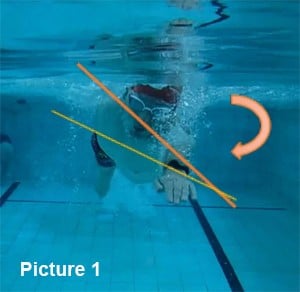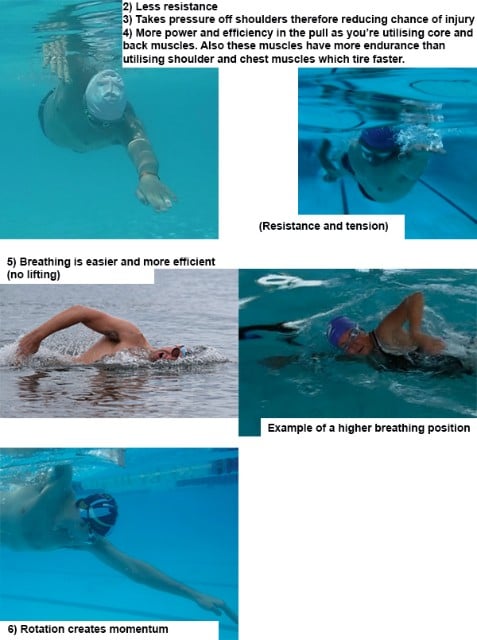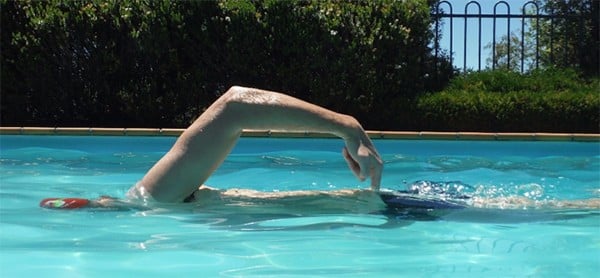As the fourth of a series of articles looking at the basics of front crawl technique, Ocean Walker coach and founder Adam Walker explains why hip rotation can really aid your freestyle swimming.
To rotate or not to rotate that is the question? Before we explore the benefits, it’s important to note there are two different types of rotation that initiate the movement.
1. Shoulder/chest driven where shoulders will move first and hips will follow.
2. Hip rotation which will lead first and chest and shoulders will follow.

There is no doubt that shoulder driven is an easier way of initiating a rotation than isolating the hips to move first. However the easy way isn’t always the right way, so the question is what is more powerful, uses less energy and takes pressure off the shoulder?
Picture 1 shows a chest/shoulder driven rotation.
You can see the orange line showing the shoulder position and the yellow line showing the hip position, where they have followed.
Hip rotation vs chest rotation
I used to swim flat and following two operations on my shoulder after swimming the English Channel I had to take pressure off my shoulders and rotating did exactly that. I tried both ways of rotating, I found a shoulder driven rotation exerted more energy, due to utilising muscles in the shoulders to send the arm into extension. It hurt me to do so and wasn’t as fast in comparison to initiating the hips first.
The rotation would actually send my hand and arm into the water without any need to drive my arm. This created a much smoother efficient entry. By rotating 180 degrees from hip to hip and maintaining core balance before finishing my pull I would maximise the power of the rotation, be the most streamlined possible and pull less weight, minimising drag as a result (like a fish). I devised a number of drills to maintain stabilisation and get the hips moving first which I teach in my 1-1s and swim camps.
Without chest and shoulders taking over a hip rotation increased my power and momentum. The proof was evident as my times started to improve and I had a lot more energy and no pain in my shoulders.
My findings were, if I didn’t rotate, I couldn’t create any momentum and therefore glide, so I had to rely on lots of arm strokes to pull me forward. This meant I used up a lot more energy/calories and my shoulders would feel the strain.
Hip rotation – explore the benefits
1) Extended Reach for the pull and catch
(Give it a go. Stand with your arm raised shoulder height in front of you about another hand from a wall, then turn onto your side (still pointing your hand at the same point on the wall). Just by turning onto your side, you have extended your reach, and therefore your pull without actually extending from your shoulder).

Rotation is the power source for many other sports!!
Interestingly hip Rotation is used as a power source in other sports which require overhead throwing in which the body rotates to face forward from a sideways position. These include cricket, javelin throwing, tennis, shot put etc. However it not just over head throwing sports, take golf for example it’s the hips that power the swing. In football and rugby kicking the ball requires hip to be driven through the line of the ball to transfer the power. There are many more sports and activities that use hip and core for strength and power.
However, one of the most similar actions to swimming is paddling in kayaking. When I looked in to the movement on ‘how to paddle’ in kayaking it was very clear that each paddle stroke is powered from the hip NOT CHEST AND SHOULDERS! The explanation being power comes from hip rotation and takes pressure off shoulders to avoid injury. This made total sense to me, so the question to myself was why not use this movement in swimming!
In Conclusion
The concept of rotation in swimming has been around a long time now, however how you rotate is important, as it can effect your speed, efficiency and even avoid injury. My advice: Allow the hips to instigate and control the movement with no interference from a driven front arm and you will see and feel the difference!!















